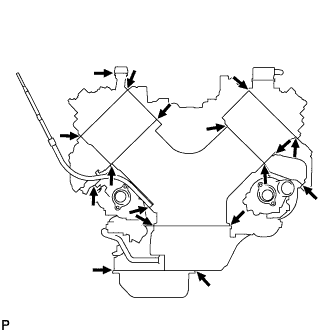Land Cruiser URJ200 URJ202 GRJ200 VDJ200 - 1VD-FTV EMISSION CONTROL
EMISSION CONTROL SYSTEM - ON-VEHICLE INSPECTION
- HINT:
- In a malfunction where the EGR system is always on, black or white smoke may be emitted from the exhaust pipe.
| 1. CHECK SEATING OF EGR VALVE |
Start the engine, and then check that the engine starts and runs at idle.
| 2. CHECK ENGINE CONDITION |
Connect the GTS to the DLC3.
Start the engine, then run it at idle.
Turn the GTS on.
Warm up the engine.
- HINT:
- The coolant temperature should be between 75°C (167°F) and 90°C (194°F).
Enter the following menus: Powertrain / Engine and ECT / Data List / Actual EGR Valve Pos. or Actual EGR Valve Pos. #2.
Check that the value of the EGR angle is within the specification.
- Standard Percentage:
Engine Condition EGR Valve Opening Angle Expressed as Percentage During idling 0 to 65%
If the result is not as specified, refer to the EGR valve inspection procedures ().
Turn the ignition switch off.
| 3. CHECK EGR VALVE OPERATION |
Turn the ignition switch to ON.
Turn the GTS on.
Enter the following menus: Powertrain / Engine and ECT / Active Test / Control the EGR step position or Control the EGR step position #2.
Check the Data List / Actual EGR Valve Pos. or Actual EGR Valve Pos. #2 reading.
- HINT:
- Make sure the EGR valve opening angle changes according to the Active Test operation.
- Standard Percentage:
Control Range Condition Specified Condition Active Test performed (Set EGR position to 100%) EGR Valve Angle: 73 to 100% Active Test performed (Set EGR position to 0%) EGR Valve Angle: 0 to 27%
| 4. CHECK MAF AMOUNT |
Start the engine, then run it at idle.
Warm up the engine.
- HINT:
- The coolant temperature should be between 75°C (167°F) and 90°C (194°F).
Turn the GTS on.
Enter the following menus: Powertrain / Engine and ECT / Data List / MAF.
Check the MAF reading.
Enter the following menus: Powertrain / Engine and ECT / Active Test / Activate the EGR valve close.
- HINT:
- Standard (Reference):
Engine Condition Active Test Condition MAF Reading Idling Active Test performed (Set EGR position to 0%) Air flow amount changes
(Approximately 6.6 to 26.5 g/sec.)
| 5. VISUALLY INSPECT HOSES, CONNECTIONS AND GASKETS |

Visually check that the hoses, connections and gaskets have no cracks, leaks or damage.
- NOTICE:
If the result is not as specified, replace parts as necessary.

w/ DPF:
Check if the differential pressure sensor hoses are connected incorrectly, disconnected, leaking, cracked or otherwise damaged.
| *A | for BANK 1 |
| *B | for BANK 2 |
| 6. PERFORM DPF FORCIBLE REGENERATION PROCEDURE (w/ DPF) |
Disconnect the cable from the negative (-) battery terminal or remove the EFI MAIN fuse for 1 minute or more.
- HINT:
Connect the GTS to the DLC3.
Start the engine and idle it until the engine coolant temperature reaches 70°C (158°F) or higher.
Move the shift lever to P and set the parking brake.
Turn the GTS on.
Enter the following menus: Powertrain / Engine and ECT / Active Test / Activate the DPF Rejuvenate (PM).

- CAUTION:
- Before performing the Active Test, make sure that there are no combustible materials around the DPF and tailpipe.
- NOTICE:
- If the ambient temperature is 30°C (86°F) or higher, the DPF and surrounding area become very hot. Use a fan, etc. to cool the exhaust gas temperature sensors, air-fuel ratio sensor and surrounding areas.
- HINT: